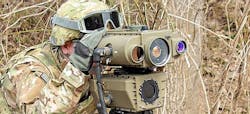Laser target designators augment GPS with celestial navigation to enhance accuracy
Executives at the Northrop Grumman Laser Systems segment in Apoka, Fla., have announced an agreement to collaborate with Trex Enterprises to apply celestial navigation subsystems for military products and scientific applications.
Related: Air Force funds design of better star tracker
This collaboration could combine one of mankind's most recent navigational technologies -- laser designators -- with celestial navigation -- one of the oldest known navigational methods.
Adding celestial navigation capability to target laser designators also could enhance accuracy if GPS-based satellite positioning systems were to be damage or otherwise incapacitated, or if signals from GPS satellites are being jammed, disrupted, or degraded.
Celestial navigation, first used by the Phoenicians, Greeks, and ancient Polynesians, enables mariners to sail far from land by following the known positions of the sun and stars. Spanish, Portuguese, and English sailors during the Age of Exploration used celestial navigation to cross the Atlantic Ocean from Europe to the New World. Magellan and Sir Francis Drake relied on celestial navigation in the 16th century as the first mariners to circumnavigate the globe.
Related: Tiny, rugged laser target designator for small UAV payloads introduced by Elop
Modern celestial navigation uses triangulation combining time, the sun, and the stars to determine one's position on the Earth. Navigators use a sextant to measure the angle of the sun or a star from the horizon at a known time. Even on modern naval warships it is common practice for the ship's navigator to take a noon sun sighting with a sextant to back up GPS measurements.
Northrop Grumman Laser Systems specializes in laser target designators that enable infantrymen, combat air controllers, and other specialists on the ground to detect, identify, and locate potential targets for attack aircraft and artillery. Laser designators precisely measure the distance from the laser to the target, and relay positioning information to bombers and artillery. Adding celestial navigation capability to target laser designators can enhance their accuracy.
Related: Trex Enterprises to help DARPA investigate new kinds of 3D electro-optical imaging sensors
Trex Enterprises applied for a U.S. patent in 2007 for a celestial compass, which includes a camera with a wide-angle lens suitable for viewing a large portion of the sky. The celestial compass has a multi-million-pixel sensor for collecting images of celestial objects such as stars, planets, the Moon, and sun.
The compass also includes a computer programmed with an astronomical algorithm for providing the precise position of celestial objects based on precise input of date and time of day, as well as the latitude and longitude of the celestial compass.
Related: Army, Northrop Grumman, BAE move forward on next-generation JETS infantry targeting system
The device also has celestial navigation and coordinate transformation software to correct distortion, convert pixel image data to astronomical coordinates, and determine the instrument's azimuth.
Over the last seven years experts from Trex Enterprises have matured this core celestial compass technology for providing an accurate celestial navigation subsystem for military products and scientific applications.
Northrop Grumman has completed formal qualification for its ground soldier targeting system with the celestial navigation technology and is delivering systems to support deployed warfighters.
Related: Northrop Grumman joins DARPA sensor-fusion program to reduce military reliance on GPS
"The synergy between Trex research and development expertise and Northrop Grumman engineering and production capability will surely increase and accelerate benefits to our soldiers," says Ken Tang, chairman and CEO of Trex Enterprises.
Trex Enterprises specializes in improving performance across the electromagnetic spectrum with technologies in microwave sensing, high resolution imaging, digital signal processing, applied optics, and materials.
Related: Nuclear ballistic missile command and control technology still a prime military concern
Northrop Grumman Laser Systems, meanwhile, has fielded thousands of portable, lightweight targeting and laser systems for ground troops and ground vehicles. These systems include ground-based man-portable, handheld and vehicle-mounted electro-optical imaging and ranging systems for target location; laser designators and markers for precise guidance of smart munitions; and airborne laser rangefinders and designators fielded onboard many of the sophisticated manned and unmanned aircraft.
For more information contact Northrop Grumman Laser Systems online at www.northropgrumman.com, or Trex Enterprises at www.trexenterprises.com.
